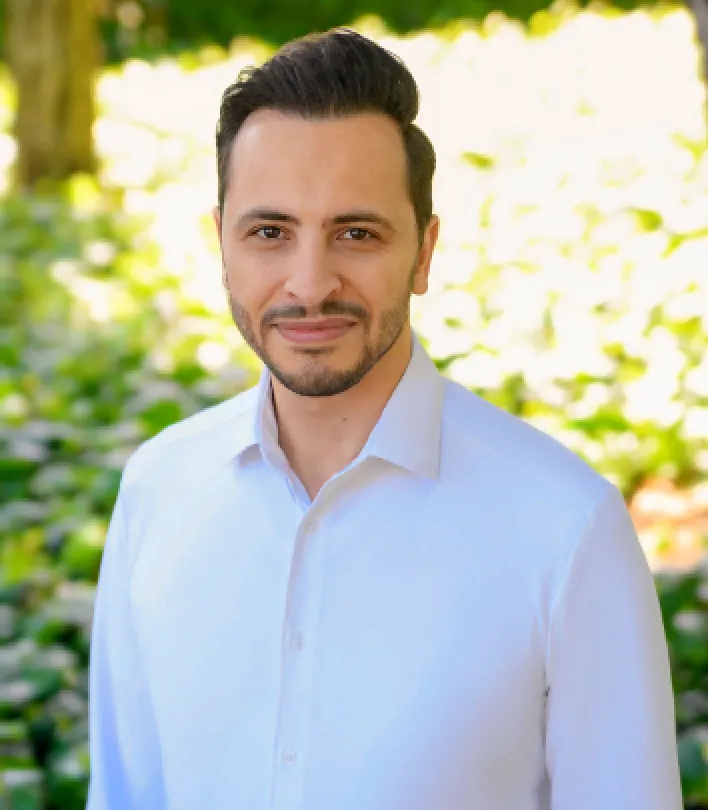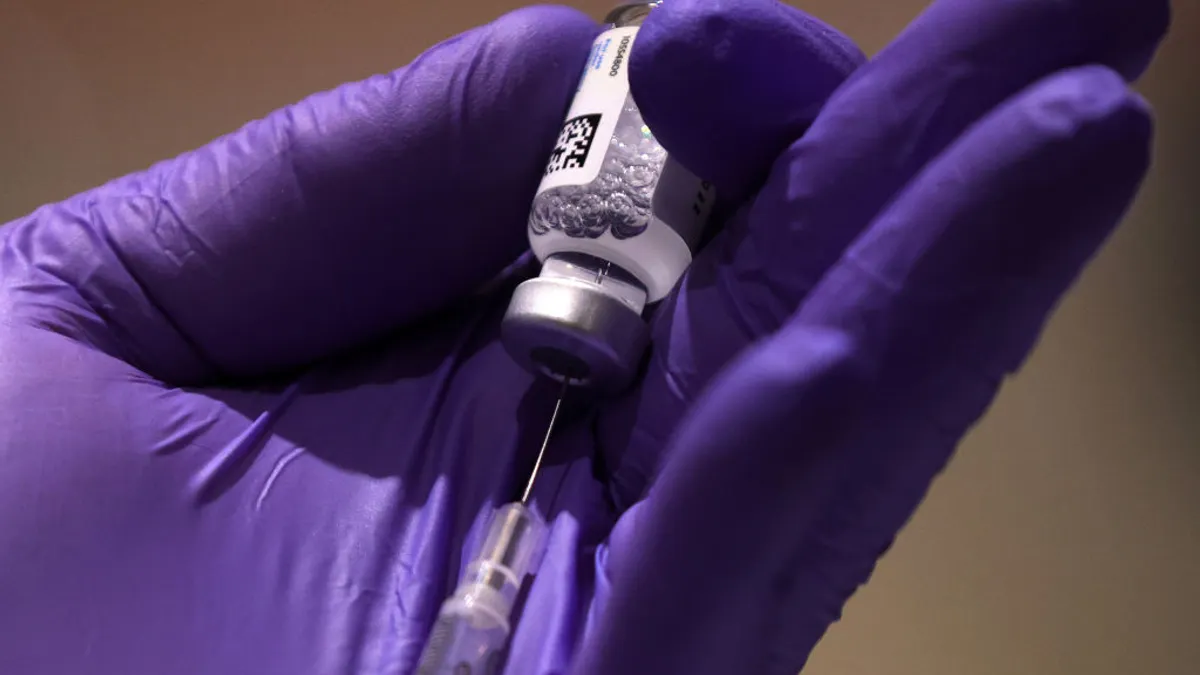The pharma industry has long been keyed into the excitement about AI. And the predictions for its potential impact are staggering.
AI tools could generate $60 billion to $110 billion in value for pharma per year thanks to boosts in operating efficiencies, R&D speed and data insights, according to an analysis published by The McKinsey Global Institute in January.
PwC also illustrated the potential returns from AI adoption on a per-company basis in a report this year.
“Overall, pharma companies that industrialize AI use cases completely across their organizations have the potential to double today’s operating profits by boosting revenues and reducing costs. We expect that this industrialization process will begin to be fully realized by companies prioritizing AI by 2030,” the PwC analysts wrote.
Although AI adoption has historically been slower in pharma than in other industries such as retail, PwC noted that “pharma [is] closing the AI value gap in an accelerated way.”
As more pharma companies leverage AI tools, what unique insights are being revealed? Here’s what several industry leaders using and developing AI tools told us.
The factors that truly impact trial outcomes
Dave Latshaw is CEO of Biophy, an AI company with solutions designed to predict clinical trial outcomes and speed drug development tasks.

“For any given trial phase, [when] you can look at all [what’s] impactful to the outcome, if [there were] just a few smoking guns that would always dictate whether or not a trial succeeds, they would be very overweight factors in the model and the rest wouldn’t matter. But the truth — and why it is complex — is that when you look at a massive number of features and the magnitude of the impact over all of them, it doesn’t reveal any one or two factors that are absolutely critical. They are all interdependent and all have the same magnitude of impact. That means you have to have to do a lot of things right to have a successful trial.
Here’s an example of what could be more important: Endpoint selection. A lot of times there will be sets of endpoints that are typically used, and some have to be for regulators, but sometimes the selection is a company’s decision. Sometimes people are surprised to understand the variability of performance for certain endpoints and that it’s very different from what they expected. The common wisdom is to use what everyone else uses.
But there might be a better endpoint that could be used [to] capture the information at the same level of detail to provide the evidence you need but is maybe more consistent and doesn’t have the risk of some inherent mechanism for variability that could throw off results. For example, some therapeutic areas, like psychiatric indications, often have a really enhanced placebo effect that can undersell the efficacy of an individual drug. But that variability with the placebo — not the drug — is the factor that sinks the trial. And when you choose a placebo you’re subjecting yourself to more randomness than you may want.”
Predicting patient outcomes
Miruna Sasu is CEO of COTA, which specializes in solutions that leverage real-world data to support oncology research. COTA also recently introduced a suite of AI-powered solutions called CAILIN designed to generate insights from RWD and datasets for research.

“You treat [patients but] you want to understand what’s going to happen. Is the treatment going to stop the disease? Or just lessen the progression? We’re finding that we have the ability to predict that, which is further analysis than we thought we would get. With clinical trial data, you only have a point in time. Here you get more of the patient journey.
We also enhanced some of our data points with genomics, and [then] you have the ability to see which genes are turned on and off before and after the treatment. And if you do that again and again you understand that patient’s pattern. Doing this manually would consume a whole person’s career, but with an algorithm you can tease apart which genes are turned on and off and which cancer, for example, could be optimally treated with which biomarker inhibitor. You have the ability to almost look into the future.
In the long run, a drug candidate would come out of discovery and go right into a real-world model and be tested against patient populations to see if it’s going to work and by how much. The technology is there to allow for that.”
Deeper insights into when genes are expressed
Craig Thompson is CEO of Cerevance, a biotech leveraging a large collection of brain tissue samples along with AI/ML tools to develop drug candidates for the CNS space.

“What we have been more surprised by is looking at certain genes by cell type and seeing when some of them are intrinsically upregulated or downregulated. And we always like to test what we’re seeing with our machine learning capabilities.
Some companies are looking at genes that we see using our machine learning are only transiently upregulated or downregulated at a certain point in disease progression, so you scratch your head about why they’re going after that target. In certain cases our technology has shown some pharma companies going after targets that aren’t expressed in the human brain and they’ve gone into phase 2 or 3 trials and then failed. At the other end, in the [neurodegenerative] space you see some targets that companies are pursuing that you don’t [understand] because the gene is extremely broadly expressed. Our anticipation is given the broad expression you would see high rates of adverse events and some of those compounds are being advanced in the clinic.”
AI solutions need to be supported by digital infrastructure
Dr. Mert Aral is the chief medical officer of Huma Therapeutics, which develops remote patient monitoring solutions used in decentralized clinical trials that is also aiming to create a platform any company can use to build their own healthcare apps.

“We’re looking at how we can enhance engagement and compliance and how we can provide patient education and awareness. We know these AI solutions work. We know they accelerate time to treatment change. We know we’re delivering data and real-world evidence to pharma. But how can we increase scale?
Right now, [solutions such as digital health monitoring] still rely on clinical teams. You still have a nurse that monitors the data and calls or works with patients. The generative AI is allowing that nurse to more efficiently monitor data and trends. But our thinking is: How can we replace that nurse with a GenAI nurse so we don’t need to deploy so much staff?
Of course, you would have to train these models. This is a high-risk environment and you can’t have a GenAI nurse giving the wrong advice to the patient. We still haven’t fully solved for that. But from a technology perspective, I don't think that’s the limiting step. We’ll get there and I don’t think it’s far off.
So when we look at GenAI it’s not just the many applications of it. We need to also have the right digital infrastructure to launch and train and deploy these solutions at scale, and our health systems are not quite there.”
AI platforms are revealing deeper levels of biology and chemistry, while creating long-term value
Ayman AlAbdallah is a partner with Mubadala Capital, a venture firm that manages over $24 billion in assets, including about 45 life sciences companies.

“We’ve seen the application of AI in drug discovery and development over the past 10 years and different waves of the technology have built on top of each other. One observation is that the value of AI companies will continue to accrue in the pipelines they generate.
The intention is not to replace the scientist but to supercharge the scientists with a better understanding of biology and chemistry to develop drugs in a much more efficient and effective manner. We’re also generating insights that were otherwise not possible using conventional assays or analytics. The examples are many.
One of our investments — Iambic Therapeutics — is leveraging physics-informed AI to propel the field forward in how we use computational biology and chemistry to discover and develop drugs. Another company Vevo Therapeutics is developing large language models for biology and moving in vivo drug discovery from a downstream step that is limited in terms of its representation of tumor heterogeneity into early-stage development to uncover misunderstood or novel mechanisms of action and new drug combinations that can result in high efficacy.”




















